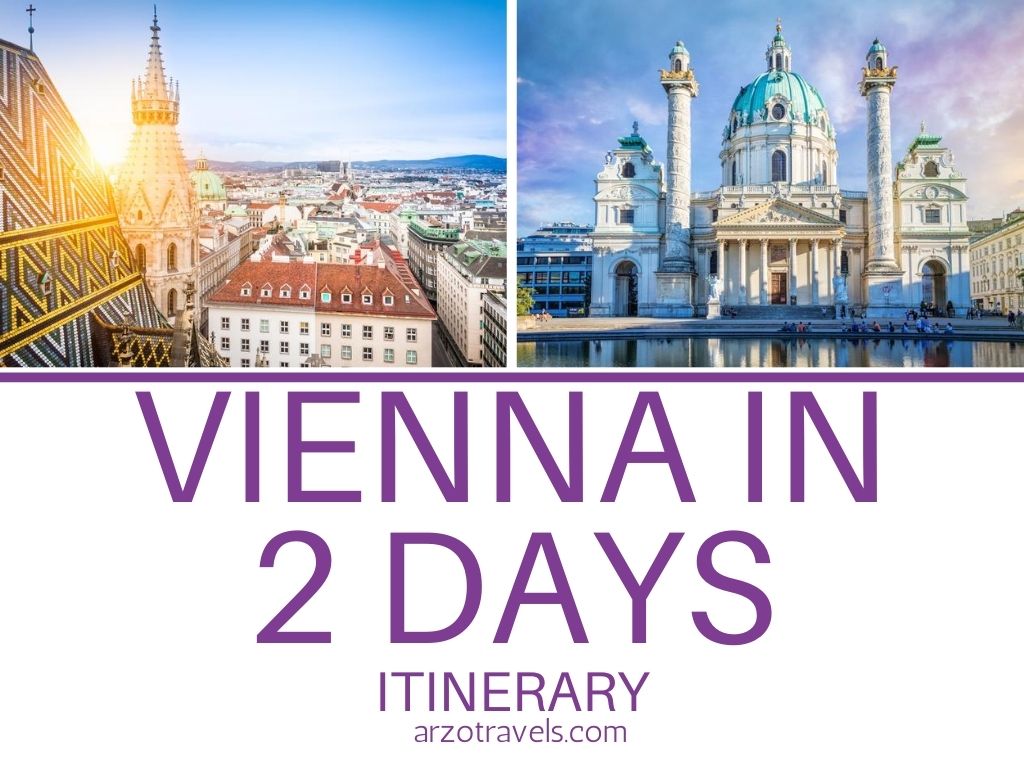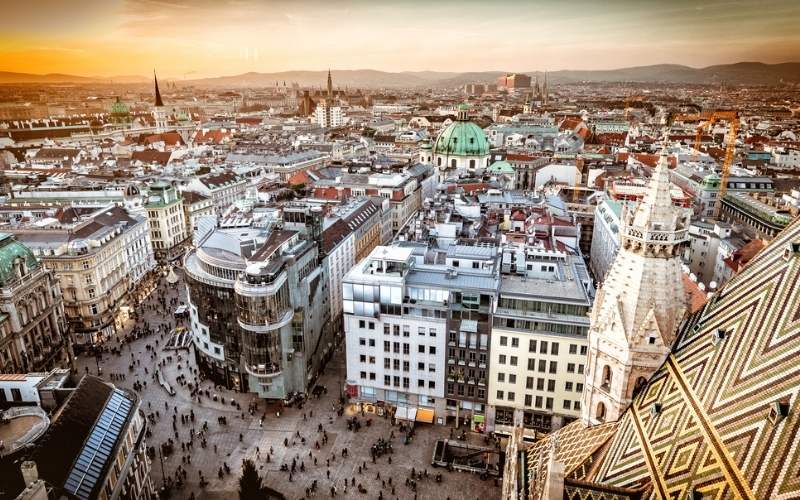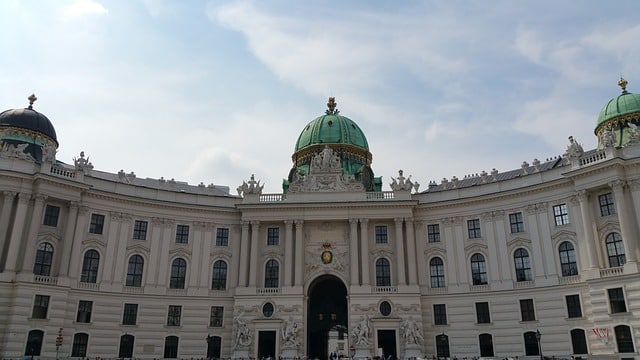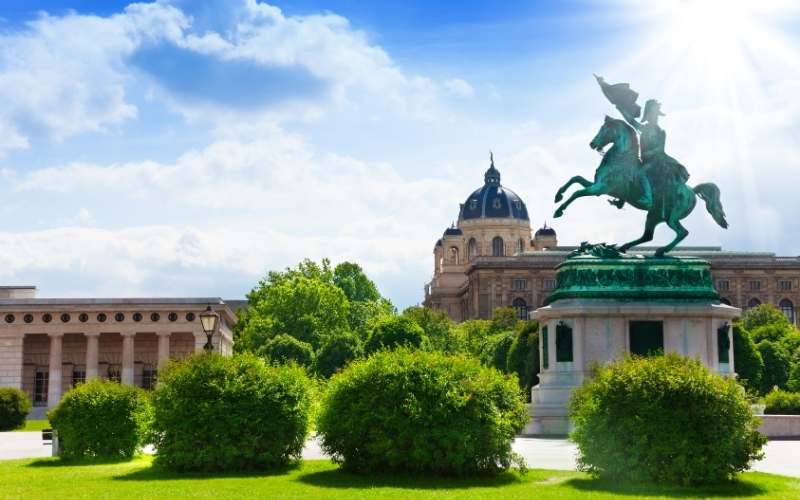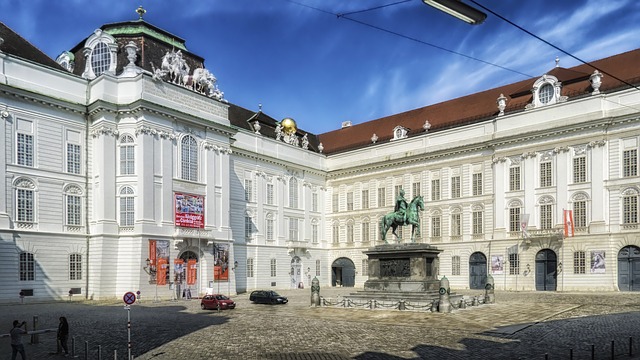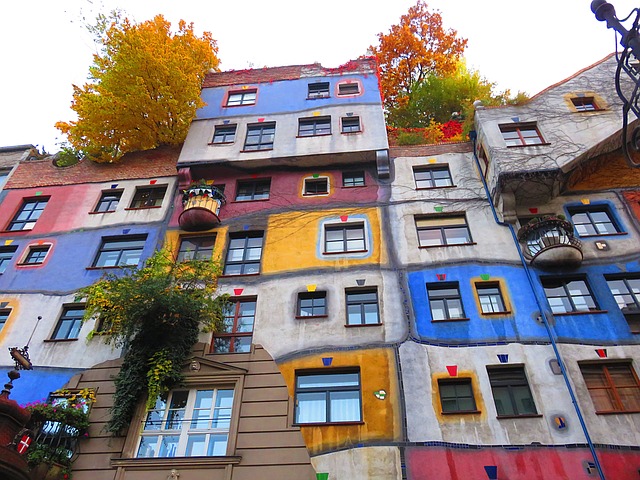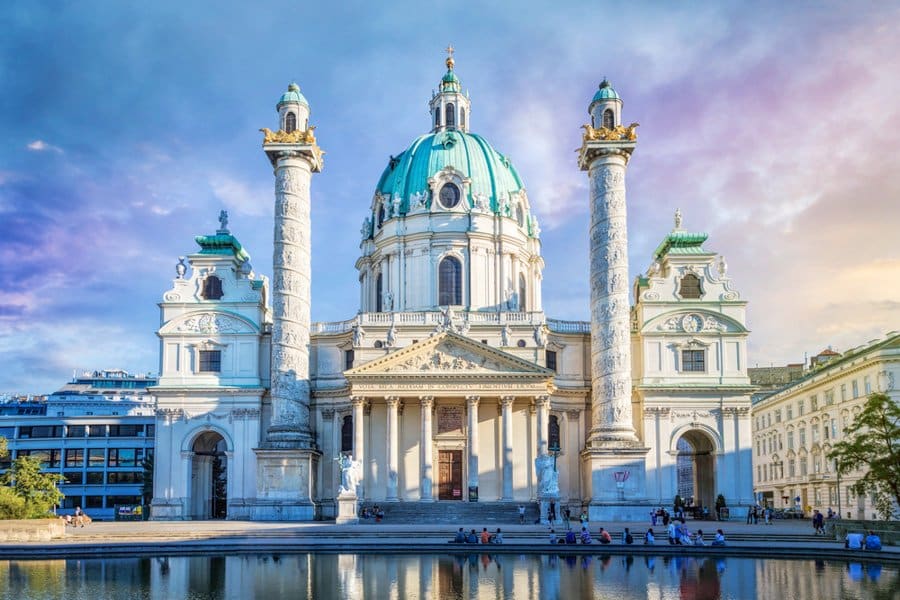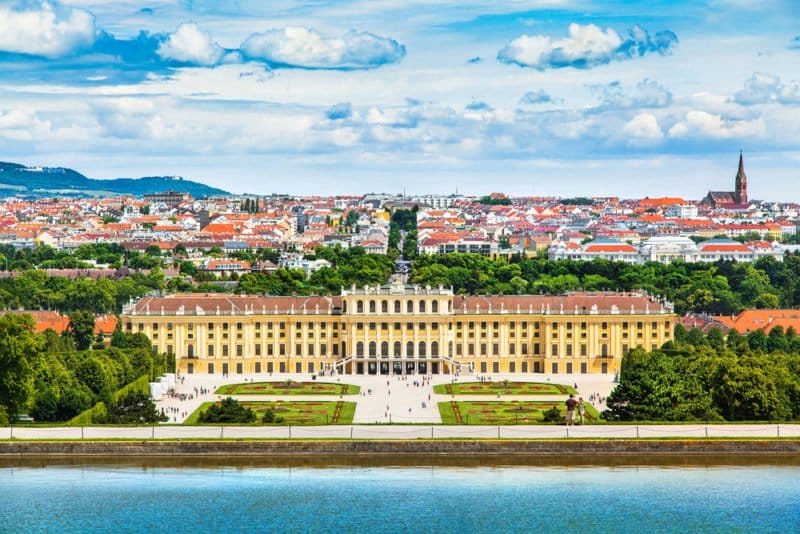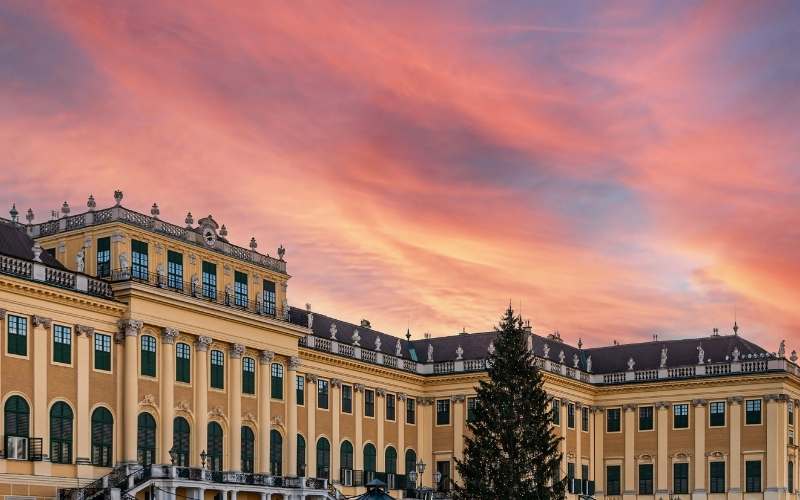HOW TO CREATE YOUR VIENNA 2-DAY ITINERARY
Are you planning your 2-day Vienna itinerary and wondering about the best things to do? This post is for you. I am sharing my tips on the best places to visit in Vienna in 2 days, along with many travel tips.
Disclaimer: This post contains affiliate links. This means I might earn a small commission when you buy a product or service via my link (at no extra cost to you). More about it here.
TRAVEL TIPS FOR 2 DAYS IN VIENNA ITINERARY
Before jumping to the best places to visit, here are some travel tips.
Get from the Vienna airport to the city center
The airport is just around 15 km (10 miles) outside of the city center, so getting to and from Vienna airport is super easy.
ℹ️ Buses and trains get to and from the airport, of course. Buses are a bit slower, take about 40 minutes, and cost less than $3 one way. The train takes just around 15 minutes, and prices are a bit more than $20 for return tickets.
ℹ️ You can book your private transport or hop on a taxi. However, unless you are exhausted, or money really does not play a role, I suggest using buses or trains.
How to get around
👟 Vienna is a very walkable city. Many of the main attractions and historic sites are in the city center, and I mostly walk whenever I am in Vienna – it is the perfect place for nice strolls and endless walks. This way, I do not miss out on one of the many gorgeous buildings on the side streets.
🚌 Only a few attractions are further away, so I use public transport. Vienna has a well-developed public transportation system, which includes buses, trams, and a metro system (U-Bahn).
The public transport is excellent but also quite affordable (8€ for a 24-hour ticket or 14,10€ for a 48-hour ticket).
There are also hop-on and hop-off buses in Vienna, which are super convenient.
Is Vienna safe?
Vienna is quite safe, though pickpocketing is very common. Be aware of your belongings and be attentive. Avoid side and dark streets at night and exercise common sense.
Where to stay
- 🛏️ HOTEL SACHER: Find luxury at its best at Hotel Sacher near the Hofburg. The hotel is rated the best in the city – its central location makes it a perfect hotel for your Vienna trip. Find out more about the rates for staying in this hotel here.
- 🛏️ MERCURE VIENNA FIRST: One good medium-priced accommodation to stay in Vienna is Mercure Vienna First – it was the place I stayed in when I visited Vienna on my last trip. Find out more about that particular hotel by clicking here.
2 Days Vienna Pass vs. Vienna Card
- ℹ️ The Vienna Pass gives free access to more than 60 attractions around Vienna. In addition, you can skip the line entry to popular Vienna attractions, including the Vienna Hop On Hop Off sightseeing tours.
- ℹ️ Tickets are a bit more expensive than the Vienna City Card but give you unlimited free public transport in downtown Vienna (public transportation is, in general, quite affordable in Vienna) and good discounts on the major attractions.
PLACES TO VISIT IN VIENNA IN 2 DAYS
Vienna is geographically not very big, and many sights are close to each other. So, it might look like a very busy itinerary – and it is – but it is doable! Feel free to skip any activities that are not appealing to you.
DAY 1 IN VIENNA
So, without further ado, let´s start with your Day 1 in Vienna.
St. Stephen´s Cathedral
Start your trip with a stop at St. Stephen´s Cathedral – the dazzling symbol of Vienna, standing right in the heart of the city!
Cathedral & Towers
St. Stephen’s Cathedral is 107 meters high – that south tower stands tall at 136 meters – making it Austria’s highest church!
Tackle the 343 steps up to the tower room and get rewarded with one of Vienna’s best views — totally worth the leg workout.
High above, the rooftop of St. Stephen’s Cathedral is covered in colorful tiles that create two striking designs: the double-headed eagle, symbolizing the former royal and imperial power, and the coat of arms of Vienna, representing the city’s proud identity.
FUN FACT: St. Stephen’s Cathedral isn’t just a historic landmark; it also has a sweet side. You’ll find its silhouette proudly featured on the iconic pink-red packaging of Manner wafers, one of Vienna’s most beloved treats
As a non-Christian who appreciates fine architecture, I can’t help but swoon over the church’s beauty, both inside and out! Even if my taste leans more toward Baroque than Gothic architecture, this gem is definitely worth a stop — it’s a visual feast.
St. Stephen´s Cathedral Catacombs
St. Stephen’s Cathedral offers more than altars and relics — deep beneath it lie the catacombs, holding the bones of over 11,000 souls in a chilling reminder of Vienna’s past.
- Just remember to dress appropriately (cover shoulders and knees) and learn about its myths, and many more European myths.
- You can climb the towers (south and north towers) and admire the view of the city (each tower charges you a fee).
- Visit the catacombs and do a guided tour. The tours take place several times a day and last about 30 minutes.
The Hofburg
From the Cathedral, you can walk towards the Hofburg – one of the world’s largest and fanciest palace complexes! Once upon a time, the Habsburgs ruled the roost for seven centuries! It’s now THE place to be for museum lovers, political enthusiasts, and event connoisseurs!
Step into the former world of the Habsburgs as you explore the grand chambers and galleries tucked inside Vienna’s Imperial Palace. What began in the 13th century grew into one of the largest palace complexes in the world — a 300,000 m² labyrinth of imperial ambition.
Expanded over centuries by successive emperors, the Hofburg now includes 18 wings, 19 courtyards, and around 2,600 rooms — some of which are still in daily use by nearly 5,000 people. Today, it also serves as the official residence and workplace of Austria’s federal president.
SISI MUSEUM
Curious about the real Empress Elisabeth — better known as Sisi? Then the Sisi Museum is your perfect starting point. Forget the romanticized “Sissi” film series (confession: I haven’t seen them either) — this exhibition dives into the complex, often surprising life of the woman behind the myth.
From personal belongings to private letters, the museum reveals Sisi’s double life: one as an iconic royal figure, the other as a restless soul searching for freedom far from the imperial spotlight.
Grand Hall of the Austrian National Library
Did you know Vienna’s Imperial Palace is home to the Austrian National Library? Step back in time at this grand Baroque library, home to over 200,000 historic books.
At its heart lies the breathtaking Grand Hall — nearly 80 meters long and soaring 30 meters high beneath a magnificent dome. It’s no surprise this space is often called one of the most beautiful library halls in the world.
Museum District
Make your way from the Hofburg to the MuseumsQuartier — it’s about a 15-minute walk, but don’t rush it. Take your time and enjoy a few detours along the way, like a stop in the lovely Burggarten. This part of Vienna is so picturesque, you’ll be glad you wandered a bit off track.
Covering 90,000 m² and home to around 60 institutions, the MuseumsQuartier is a cultural powerhouse in the heart of Vienna. Think of it as a creative playground — where art, music, fashion, literature, theater, design, and even gaming come together in one dynamic space.
From contemporary exhibitions and open-air performances to family-friendly zones and bold street art, there’s something here to inspire every kind of culture lover.
I’m not usually a museum person, but I remember really enjoying my stroll through the MuseumsQuartier. Even if exhibitions aren’t your thing, the area itself is well worth exploring — it has a great atmosphere and plenty to see just by walking around.
- You can enjoy some of the finest art museums in Vienna in this area, including the Museum of Modern Art Ludwig Foundation Vienna (MUMOK) or the Leopold Museum.
- So choose the museums you are interested in, and with 2 days in Vienna, you have time to visit a museum or two.
Hundertwasser Village
To reach the Hundertwasser Village and the nearby Hundertwasserhaus, hop on public transport or take a scenic 45–50 minute walk (about 3.5 km) through Vienna’s charming streets.
Designed by the visionary Friedensreich Hundertwasser, the Hundertwasserhaus is a vibrant, quirky masterpiece — a must-see if you enjoy colorful, unconventional architecture. I remember being completely fascinated by the details; it feels more like stepping into a painting than visiting a building. Even if you’re not into architecture, it’s hard not to be drawn in by its playful energy.
Designed by the brilliant Friedensreich Hundertwasser in 1990 and 1991, the Hundertwasser Village is full of color, curves, and character.
Wander through its eclectic shops, grab a coffee, and don’t forget to look up — the rooftop is home to a small forest of around 30 trees, some reaching up to 15 meters high. It’s a quirky little world of its own, and well worth a visit if you’re in the mood for something a bit different.
- Though it is an unusual attraction – or maybe because it is an unusual attraction – about 1,2 million people visit Hundertwasser every year.
- Opposite the Hundertwasser Village, you will find the Hundertwasserhaus – you can admire this colorful building only from the outside.
- Free admission to the Hundertwasser Village.
Viennese Prater (2. District)
For the late afternoon or evening, I recommend heading to the Prater — either by public transport or on foot from the Hundertwasserhaus if you’re up for a longer walk.
Tucked into one of Vienna’s greenest corners, the Prater blends old-school charm with lively fun. At the heart of it stands the famous Giant Ferris Wheel, one of Vienna’s most iconic landmarks. Built in 1897, it rises nearly 65 meters into the sky and has been spinning ever since, offering fantastic views and a touch of nostalgia.
And it doesn’t stop there: the Prater is packed with classic carousels, amusement rides, and plenty of snack stands where you can grab anything from cotton candy to bratwurst. It’s the perfect spot to unwind and enjoy a playful end to your day.
- There is no entry fee. You have to pay for each roller coaster/snack, etc.
- If you spend more time in the Museum district or travel a bit more slowly, you can skip this and head to the next area.
- While the Ferris wheel is open all year, most stalls are only open from March to October.
Karlskirche / St. Charles Church
Extra Tip: If you have a bit more time, take a short detour to visit the Karlskirche — one of Vienna’s most striking churches and a true architectural jewel.
Dedicated to St. Charles Borromeo, the personal patron saint of Emperor Charles VI, the church is both a spiritual landmark and a symbol of Habsburg devotion. The two monumental columns at the entrance — each standing 47 meters tall — depict scenes from the saint’s life and are impressive even from a distance.
If you’re lucky, you might catch a performance of Mozart’s Requiem echoing through the grand interior. But even without a concert, the church’s baroque beauty makes it well worth a visit.
DAY 2 IN VIENNA
For your second day in Vienna, I suggest exploring two of the most impressive castles in Europe.
Schönbrunn Palace
Schönbrunn Palace is without a doubt one of the most stunning palaces in Austria — and possibly the crown jewel of Vienna. As a UNESCO World Heritage Site and the city’s most visited attraction, it draws in over two million visitors each year.
But what exactly is Schönbrunn?
The story begins in 1569, when the Habsburgs took over the estate. And let’s be honest — who would willingly give up a property like this? In 1642, Eleonore von Gonzaga, wife of Emperor Ferdinand II, decided she needed a cozy little pleasure palace and named it Schönbrunn, meaning “beautiful spring.”
Fast forward to 1743, after Vienna had recovered from the Ottoman siege — Maria Theresa went full throttle on transforming Schönbrunn into a grand baroque palace. It became the imperial summer residence, and over the years, hosted the likes of Emperor Franz Joseph and Empress Elisabeth (yes, our Sisi!).
Personally, I found the whole place jaw-droppingly majestic, from the grand halls to the dreamy garden paths. You get a real sense of imperial life, and honestly, it’s hard not to imagine yourself in a powdered wig, casually strolling through the corridors.
Out of the palace’s 1,441 rooms (yes, really), 45 are open to the public. The interiors range from lavishly gold-leafed rooms to surprisingly personal spaces, offering a fascinating peek into Habsburg life.
Don’t miss the Schönbrunn Maze. Once the royal family’s playful escape, it’s now open to everyone — perfect for getting lost in the hedges (on purpose). Keep an eye out for the zodiac-themed surprises tucked inside, and if you climb the viewing platform, you’ll get a fun perspective on others trying to find their way out.
- The palace is open daily, even on bank holidays.
- The very best thing is that Schönbrunn Palace Park is free of charge. However, you have to pay an entrance fee if you visit the Palace.
- You can do different kinds of tours.
- However, as fascinating as it is, I suggest spending max. half a day here, as there is another fantastic castle waiting for your visit!
- Ticket prices: Free with the Vienna Pass and a discount with the Vienna City Card.
Schloss Belvedere
Ah, Vienna — a city where palaces seem to grow like flowers! And just when you think you’ve seen it all, along comes another architectural gem to impress you: Schloss Belvedere, one of Vienna’s most iconic landmarks and, yes, another UNESCO World Heritage Site.
Let’s talk about Prince Eugene of Savoy — a military genius with surprisingly refined taste. He had the Belvedere built in the early 1700s as a summer escape, complete with sweeping gardens and space to house his beloved art collection. Honestly, I can’t blame him — if I could escape the city heat in a palace surrounded by art and fountains, I’d do the same.
Even if you’re not a hardcore art lover (I’m definitely more of a “wander and soak it in” kind of visitor), the Belvedere makes it easy to appreciate. I still remember standing in front of Klimt’s The Kiss and thinking, “Okay… now I get the hype.” And the gardens? Absolutely dreamy. I spent more time there than I planned, just wandering around and enjoying the peaceful vibe.
The Belvedere, originally just beyond the city gates, now sits in Vienna’s southeastern part and is super easy to reach. The two Baroque buildings — Upper and Lower Belvedere — take you on a journey through centuries of Austrian art, all while surrounded by elegance and charm.
- Ticket prices: Free with the Vienna Pass and a discount with the Vienna City Card.
Sofitel St. Stephansdom (Best View of Vienna)
Now’s the perfect moment to slow down and soak it all in — whether with a drink in hand as the city lights begin to shimmer, or a memorable dinner accompanied by sweeping views of Vienna.
I was just wandering around, not expecting much, when I stumbled across the Sofitel St. Stephansdom. And let me tell you, the views from up there? Absolutely stunning. Even with the cloudy weather I had, it was still one of those “wow” moments.
The restaurant is a fantastic way to wrap up your two days in Vienna. If the weather’s on your side, the panorama is even more impressive. And if you’re visiting during peak season, I definitely recommend calling ahead to book a table by the window — those views are in high demand, and for good reason!
FINAL THOUGHTS FOR A 2-DAY ITINERARY FOR VIENNA
After two unforgettable days in Vienna, I’m pretty sure this city will leave a lasting impression. Let’s be real — this 2-day Vienna itinerary is ambitious. You might need to skip a stop or two for the sake of energy (and your feet), but it’s absolutely doable and packed with the best Vienna has to offer.
- Vienna is a must-see on any Austria itinerary.
- Visiting Vienna in winter? Then check out my Vienna winter guide here.
- If you need more reasons to visit Vienna, read Rachel´s blog post on why she fell in love with Vienna.
- And read this if you are looking for the top things to do in Vienna
